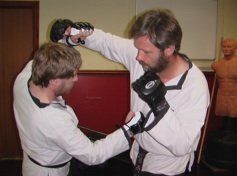Boxing
The word "boxing" first came into use in England in the 18th century to distinguish between fighting to settle disputes,
and fighting under agreed rules for sport. It is now used to describe a sport in which two contestants (boxers) wearing
padded gloves face each other in a "ring" and fight an agreed number of "rounds" under recognized rules.
Generally, in boxing there are four types of punches, all other punches basically being variants of these; the Jab, Hook,
Uppercut and the Cross.
MUKA BAZI
Muki boxing is an ancient form of bare-knuckle boxing and the roughest form of unarmed fighting arts in India and possibly
anywhere in the world. The practitioners harden their fists by striking against hard objects like stony surfaces. Breaking
coconuts and bricks are used to test the conditioning of the fists.
Practiced in Benares, North India, fighting could occur between two individuals or in-groups. When in two groups the fight
would begin between two people, usually the younger ones. As things develop, older ones start to fight in pairs and soon the
fight turns into a `free for all` between the two groups. The fight continues until one group is driven back. Many competitors
are injured, some seriously.
Muki boxing was banned by the Indian government for being too dangerous because injuries where often frequent and grievous.
Actual combat now being forced underground. Open practice, without combat still continued using the more acceptable name
of Muka bazi. Muki means fist and Bazi has a rough translation as meaning study, ceremony, way etc.
Therefore Muka Bazi means `The path to Muki. `
Muka Bazi is not just the study of attaining physical power, but the harnessing, controlling and guiding of the intellectual and
emotional energies created.
Warning: Practicing Muka Bazi incorrectly is dangerous and can cause not only physical but intellectual and emotional damage.
